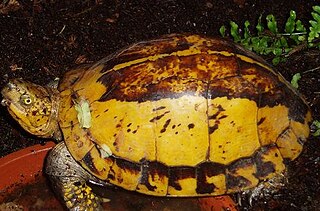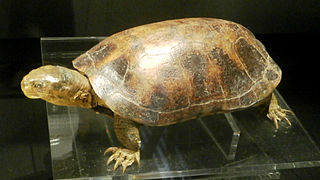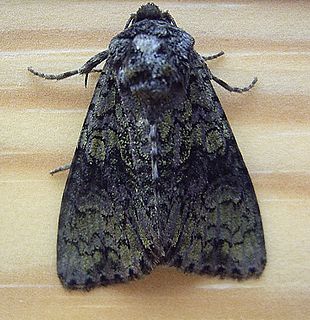
Hainan is the smallest and southernmost province of the People's Republic of China (PRC), consisting of various islands in the South China Sea. Hainan Island, the largest and most populous island in China, makes up the vast majority (97%) of the province. "Hainan", the name of the island and the province, literally means "south of the sea", reflecting its position south of the Qiongzhou Strait, which separates it from Guangdong's Leizhou Peninsula and the rest of the Chinese mainland. In the Chinese language, Hainan is officially known as Hainan Dao.

Trimeresurus stejnegeri is a species of venomous pit viper endemic to Asia. Two subspecies are currently recognized, including the nominate subspecies described here.

The Indochinese box turtle, Vietnamese box turtle, or flowerback box turtle is a species of Asian box turtles from China, northern and central Vietnam, Laos, and possibly northeastern Cambodia. It is found in high altitude woodland where it tends to hide in the undergrowth. There is considerable confusion as to the taxonomy of this species with several subspecies being recognised by some authorities. and not by others. The International Union for Conservation of Nature has rated its conservation status as "critically endangered".

The large Indian civet is a viverrid native to South and Southeast Asia. It is listed as Least Concern on the IUCN Red List. The global population is considered decreasing mainly because of trapping-driven declines in heavily hunted and fragmented areas, notably in China, and the heavy trade as wild meat.
Cephalotaxus hainanensis is a species of conifer known by the common name Hainan plum-yew. It is endemic to the island of Hainan in southern China. It is possibly a synonym of Cephalotaxus mannii.
The Hainan knobby newt is a species of salamander in the family Salamandridae. It is found only in the island of Hainan, China. It is known from the Wuzhi Mountains, Diaoluoshan, and Jianfengling. All these locations are nature reserves. Nevertheless, the species is threatened by habitat loss and degradation due to agriculture, clear-cutting and infrastructure development for tourist activities.
Hyla simplex is a species of frog in the family Hylidae found in southern China, Vietnam, and Laos. Frogs from Hainan Island can be treated as subspecies Hyla simplex hainanensis.

Limnonectes fujianensis is a species of frog in the family Dicroglossidae. It is most closely related to, and formerly confused with Limnonectes kuhlii. Its name refers to the type locality in Fujian province of China. It is also found in Hunan, Zhejiang, and Jiangxi in China as well as in Taiwan. and other sources give a somewhat broader distribution.
Odorrana hainanensis is a species of frogs in the family Ranidae that might be endemic to Hainan Island, China; there is one record from Guangxi. Prior to its description in 2001, it was confused with Odorrana andersonii.

The yellow pond turtle, is a medium-sized, semi-aquatic turtle in the family Geoemydidae. This species has a characteristic broad yellow stripe extending behind the eye and down the neck; the carapace ranges in color from grayish brown to brown and the plastron is yellow or orange with black blotches along the outer edges. It is found in East Asia, ranging from central Vietnam and Laos, north through the coastal provinces of south and central China. Additional insular populations are found in Taiwan, Hainan and the Ryukyu Islands. The Japanese populations are believed to have been introduced as a result of imports from Taiwan.

The Hainan gymnure or Hainan moonrat is a species of mammal in the family Erinaceidae. Its natural habitat is subtropical or tropical dry forests. It was thought to be endemic to the island of Hainan, China where it is threatened due to habitat loss, but in 2018 was found to also occur in, and be rather common, within Northern Vietnam.

Craniophora ligustri, the coronet, is a moth of the family Noctuidae. The species was first described by Michael Denis and Ignaz Schiffermüller in 1775. It is found in Europe, through the Palearctic to Japan.
Xenopeltis hainanensis is a non-venomous sunbeam snake species found in China and Vietnam. This is a primitive snake known for its highly iridescent scales. No subspecies are currently recognized.

Craniophora is a genus of moths of the family Noctuidae.

Craniophora harmandi is a moth of the family Noctuidae. It is found in Japan, They emerge as adults between June and September in Japan. Nepal, and the western Himalaya to Taiwan "in the region with monsoonic influence."

Craniophora sichuanensis is a moth of the family Noctuidae. It is found in China (Sichuan). The habitat consists of virgin mixed forests.

Craniophora praeclara is a moth of the family Noctuidae. Its distribution includes North Korea, Japan, China, and the Russian Far East.

Microlepia is a genus of ferns in the family Dennstaedtiaceae described as a genus in 1836. Most of the species are native to Asia, with many endemic to China, although a few species occur also in Australia, Africa, the West Indies, Latin America, and various oceanic islands.

Shortridge's horseshoe bat is a species of Horseshoe bat native to Northeast India, northern Myanmar, and southern China. It was first described in 1918 by Knud Andersen, and was considered a subspecies of Blyth's horseshoe bat until 2003 when the two species were collected in sympatry.

Celastrina gigas, the silvery hedge blue, is a small butterfly found in India that belongs to the lycaenids or blues family. The species was first described by Francis Hemming in 1928.
















